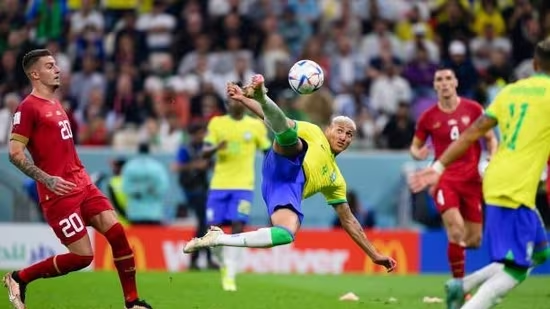Breaking down the goals that have lit up Qatar
We remember the goals. Salem al-Dawsari's curler for Saudi Arabia against Argentina. Richarlison's overhead kick for the Brazilians versus Serbia. Vincent Aboubakar's cheeky dink over the keeper in Cameroon's game against Serbia. Lionel Messi's goal (thanks to Nicolas Otamendi's hands-off assist) for Argentina vs Australia. Luis Chávez's stunning freekick for Mexico vs Saudi Arabia. Kylian Mbappe's stoppage-time goal for France vs Poland. Goncalo Ramos's first goal for Portugal vs Switzerland. Youssef En-Nesyri's header for Morocco vs Portugal. Julián Álvarez's lung-busting run for Argentina vs Croatia. The best ones stay with us a lot longer than we think possible and each time we think back to them, we find ourselves smiling. The brilliance cannot be quantified. One shouldn't try to do that either.

But while data will never tell us all we need to know about a goal, it will inform us in different ways. The speed, the angle, the area from where the goal was scored can shed light on something that we might have missed and make us appreciate the goal even more. What's more, the data can talk to us about trends in a way pure emotion never will be able to.
In the 62 matches played so far at the 2022 Fifa World Cup, 163 goals have been scored, an average of 2.63 per game. Highlight reels aside, it is goals that make most games and we saw enough of them in Qatar despite the goalless draws to begin the tournament.
The total number of goals is already the fourth highest of all-time. Russia 2018 (2.64) and Brazil 2014 (2.67) had a slightly higher frequency but the difference is negligible. With two matches to play — the final between Argentina and France and the third-place game between Morocco and Croatia — there’s a chance for this tournament to breach the all-time high of 171 goals, which was set in 1998 and matched in 2014.
Long-range duds
The Qatar World Cup has had the lowest number of long-range shots and the smallest percentage of goals scored from outside the penalty area in the last five tournaments. Through the group stage and the Round of 16, only 7.6% of goals have come from outside the box, compared to 18.6% in 2006, according to data company Nielsen Gracenote, which began tracking the statistics at the World Cup in Germany 16 years ago.
This essentially means that teams aren't being trigger happy from outside the box. But was there a reason for this? It might just come down to success percentage but teams were essentially looking to make chances and shots count. The new Adidas Al Rihla ball didn't help matters or at least that is what England right-back Kieran Trippier seemed to think.
“It’s just… I feel it’s a bit lighter,” Trippier was quoted as saying by the Daily Telegraph. “It feels if you put too much power on it, it’ll just fly away, but it’s one of those where we have to deal with that, all of us do. We train with the same ones. It’s a football, isn’t it?"
The Newcastle United defender added: “Every time I’ve crossed the ball, I’ve felt the balls are a bit different but there are no excuses, really. I would just say the balls are a bit different but it is not the heat or anything. I’m not too sure….maybe it is the players.”
Brazil were one team that didn't mind having a crack from outside the box — their 33 attempts from outside the box are the most by any team in this tournament. A total of 1383 attempts at goal were made in the tournament, of them 516 were made from outside the box and only 14 goals came off them. When the odds are so poor, it doesn't come as a surprise to see teams buckling down and looking elsewhere.
Up front
That elsewhere happened to be closer up. Right in front of goal. A place from where only Romelu Lukaku could miss. Jokes aside, after the Round of 16 in 2010, there were 102 goals from inside the box (84.3% of all goals), compared to 118 in 2018 (86.8%) and 134 (92.4%) in Qatar.
This might also be down to how teams are setting up defensively. They aren't afraid to park the bus and sit deep. When you have so many players in front of you, a long shot becomes, well, a long shot. So, the number of goals coming from crosses is up.
Fifa's Technical Study Group saw more and better crosses bearing fruit early in the tournament with a big increase in the number of goals — 14 instead of three — coming from wide areas compared to the 2018 edition. And the trend continued. Come in from the flanks, make the pace count and then cross it in. There was an average of 7.9 attempts at goal on target and from them resulted 2.6 goals on average in each match.
In 2010, the average shots per goal was 12.8. In 2014, it was 12. In 2018, it was 9.8. In 2022, the number is down to 8.4 (1383 shots, 163 goals) and that is just fabulous. So much more value for each shot and if Messi or Mbappe can make their chances count too, the final flourish of the tournament will be so much brighter.
Disclaimer: The copyright of this article belongs to the original author. Reposting this article is solely for the purpose of information dissemination and does not constitute any investment advice. If there is any infringement, please contact us immediately. We will make corrections or deletions as necessary. Thank you.







